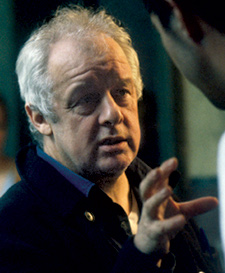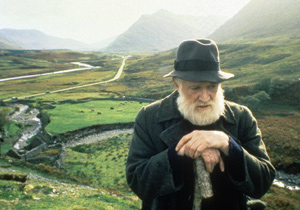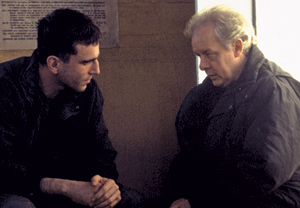BY F.X. FEENEY
 PASSION PLAY: When working with actors like Paddy Considine
PASSION PLAY: When working with actors like Paddy Considine
in In America, (2003) Sheridan holds a mirror up to human nature.
"If they don't touch something I feel, they have no reality."
(© 20th Century Fox Film Corp.)Jim Sheridan was 20 at the time, a philosophy major at University College in Dublin, Ireland. His family was eating itself up with grief and rage over the death of his younger brother, Frankie, three years earlier. His father was so devotionally focused on the memory of their departed saint that he mistreated the children who were still alive. Sheridan, the eldest son, traded blows with his father. Then he pulled a mirror from the wall and made his father confront his own face. "Look at yourself," he shouted.
"I think that was the moment I became a filmmaker," Sheridan recalls. "It was a melodramatic flourish, a weird act, but it's what you do in films—a response to power that is not verbal but an action, a gesture."
For sheer life drama and its highly personal mix of outrage and ecstatic honesty, that scene could fit snugly into any one of Sheridan's films, which include My Left Foot (1989); The Field (1990); In the Name of the Father (1993) and In America (2003). From his early 20s to his late 30s, he was an actor and theater director in Ireland and the United States, and in the mid-'80s studied filmmaking at NYU. Theater and his work with actors inform Sheridan's basic principles as a craftsman.
"I just had a natural cinematic sense from when I started. I never believed in sets when I worked in theater. I located the scene through characters and action and let the audience use their imagination."
For the most part, he argues that his feel for filmmaking is as instinctive as that gesture of making his father look at himself. Time and again Sheridan holds his mirror up to human nature, and especially fatherly nature. "Shakespeare used to write about fathers that kill their kids," he observes, in an erudite digression typical of his response to direct questions about filmmaking. "Those kinds of fathers come out of the Celtic myths. It's the kind of myth that comes out of a dominated culture."
Sheridan's mention of mythic Celtic fathers segues into talk of such mythic and afflicted brothers as Cain and Abel, a story that is crucial to his latest film, Brothers (due for release in late 2008), which is based on the 2004 Danish film written and directed by Susan Biers. He had been very moved by that film when he first saw it, intrigued by the themes of intense love and lethal jealousy between two polar opposite brothers—one a career military man, the other a lifelong screw-up who only comes into his own by caring for his brother's family after his super-achieving sibling goes missing in Afghanistan and is declared dead.
Sheridan realized transposing a Danish drama for an American audience could be risky. "You can't just microwave something," he says emphatically. "You can't just reheat it." The challenge is to find what works best in the story about Americans, for Americans. "There are rules that apply to American cinema that don't apply to other forms of cinema," he explains. "In a Danish film, people can get drunk with impunity. They can leave their kids at home unattended while they go pick up their brother in the bar. In an American movie, you're not allowed. Americans are different and the rules are different. So, all the time I'm consciously working within a framework of American storytelling."
This was a lesson he learned making In America. "I had a problem because the character of the father was a very direct self-portrait," admits Sheridan, "and as such there was no way to hide. He's a man who brings his wife and kids to New York to basically live in poverty. The American audience was likely to hate him if I didn't do something about it. So I shot a scene where he does an audition for the theater, and you can see he's a good actor. The audience can say, 'Oh, he wants to be a star,' and put aside their doubts about him. You sometimes need a goal for a character just so the viewer can relax."
Mastering this approach was a turning point in terms of how Sheridan views character development. "After In America, I believe less in character and more in essence. If they don't touch something I feel in the moment of making the film, they have no reality. They'll be cardboard. I began to believe, forward from that movie, that each character is just an aspect of one persona, pieces in an emotional puzzle for which the finished thing is the answer."
So performance is the key element in his art, but, he laughs, "I'm not even sure actors are directable. I think the more you know, the less you try to direct them. The more you just try to not impede." The goal is to encourage spontaneous discovery in the act of making the film. Working with children on In America, he engaged them by letting them call "Action!" and "Cut!" With Daniel Day-Lewis (with whom he's made three films), or Tobey Maguire, Jake Gyllenhaal and Natalie Portman in Brothers, his method of rehearsal is less about running lines than engaging in a Socratic back-and-forth, exploring what's on the page with an open mind, asking and being asked about character and story points. He is extremely comfortable at being challenged.
"I invite a certain dissonance with the actor," says Sheridan. "Most times, you want the actor to push back. Daniel is so focused, so organized that he's like a balance for my chaos. He will just do it exactly the way I imagined it when I was writing, without having to 'direct' him. Natalie is a very classical actress, very sure of where she's going—her only difficulty was her tremendous young age, being 26 years old and playing a mother of two, but she made the stretch. Tobey's very controlled, a thinking actor. Great actors on film, you always know what they're thinking. Jake's a thinker too, but more like me, questioning everything, improvising. But actors generally have got to be allowed to push back, otherwise you're just trying to fit them into a pictorial composition."
 Richard Harris in The Field (1990). (© Photofest)
Richard Harris in The Field (1990). (© Photofest)But at the same time, Sheridan understands the director has to be strong. On his second film, The Field (1990), he fought nonstop with star Richard Harris; they differed over a matter of interpretation in an early, important scene, and after that every day became an ordeal. Harris even rather loftily told him at one point, "Any problems you're having with me, you're having with your own father." But Sheridan, having already battled his father and won, refused to budge. He is very proud of the film that resulted, precisely because he and Harris both stood their ground. Shortly after that film was released, Sheridan advised young filmmakers: "If you get an actor in front of you who's fighting with you, your natural instinct is to just let him do what he wants and move on because you've got 300 people behind you. Do that, and you're in deep shit. You've got to stick with what you want."
Although Sheridan courts what he describes as a kind of "chaos" on the set, that by no means implies a passive approach. "The chaos I'm talking about is not a chaos of, 'I'm disorganized,' it's more, 'I'm so organized I just let it go.' Mine is a simpler approach, and so it is with the movies I love. Like early Scorsese, where it's all moving-camera, but then it stops mid-move to cut to something else. I love that he had the courage to move it around, but also the young filmmaker's boldness, mistakes, belief and naiveté, which all give the film a power you can't get when you're in charge of your craft."
 MOMENT OF TRUTH: Sheridan has made three films with Day-Lewis,
MOMENT OF TRUTH: Sheridan has made three films with Day-Lewis,
including The Boxer, and says he always gets exactly what he wants
from the actor. (© Frank Connor/Universal Pictures)Still, Sheridan does have a firm emotional and psychological plan going in, which derives from the script and his conversations with actors. "I don't really storyboard it out. On The Boxer I storyboarded some helicopter shots, but otherwise I proceed strictly from the emotional aspect of it. Even when I have something worked out in the script and I get to the set and don't believe the situations any longer, I have to change it." Apparently, this made life hell for his cinematographer Declan Quinn on In America as Sheridan was always coming to the set and changing his mind about camera setups.
The tricky part about going from theater, which, he says, is dependent on the voice, to film, which uses the eyes, was finding a way of working that was cinematic and fluid. "I used to do plays where everybody had to learn their lines for two fuckin' hours. In cinematic terms, one shot lasting two hours. And I did that till I was nearly 40. So when I come onto the set where I'm making a film, where the scenes are at most three or four minutes, that's so easy for a theatrical director, it's a joke. Tell me I have to direct a scene that's a minute long? I can say, 'Okay, let's start shooting it now.'"
Sheridan is after what he calls "realistic disbelief, rather than the kind of belief I think people who storyboard have—a 'God's-eye' view. 'We've worked it out and we're going to impose this vision on it.' I don't come from a place that's vision-oriented; I'm emotion-oriented. Emotions are invisible, so I'm always trying to get at the invisible—the truth of a moment. The truth of an emotion is hard to catch."
Sheridan is not the kind of film director who could imagine doing 40 takes without playing himself out. While he deeply admires artists like Kubrick, Hitchcock and the Coen Brothers—legendary preplanners—but fears that, for his own purposes, imposing a preordained, detailed idea on the evolving material would kill a film's life for him. "Van Gogh didn't plan in a storyboard way. He didn't say to himself, 'I'm going to storyboard this cornfield.' A great emotion came through him, and he painted it. Michelangelo did storyboard his paintings. His great classical style comes out of an established order. Both methods of creation are valid, but a 'felt' filmmaker like myself works like a documentary-maker."
Although he greatly respects the written word, Sheridan views film as essentially a nonverbal medium, and whether working in collaboration with writers before production or with his editors after, "I'm taking words away rather than adding them. Making a scene happen with looks and movement, those are the best scenes. The best scripts disappear when you're shooting them, like melting snow—the story is the driving force.
But for Sheridan the story is not always communicated by what you see and hear. "I have a belief in the 'invisible story' that's playing underneath the main story. You know how when you're watching a movie, your mind sometimes drifts off into contact with your own life? Movies that are too compressed into a visual concept don't allow your mind to do that. When your mind doesn't wander, there's no engagement with the subconscious, with the soul. I'm always trying to get that engagement with my deepest fears and find whatever subconscious story is trying to come out."